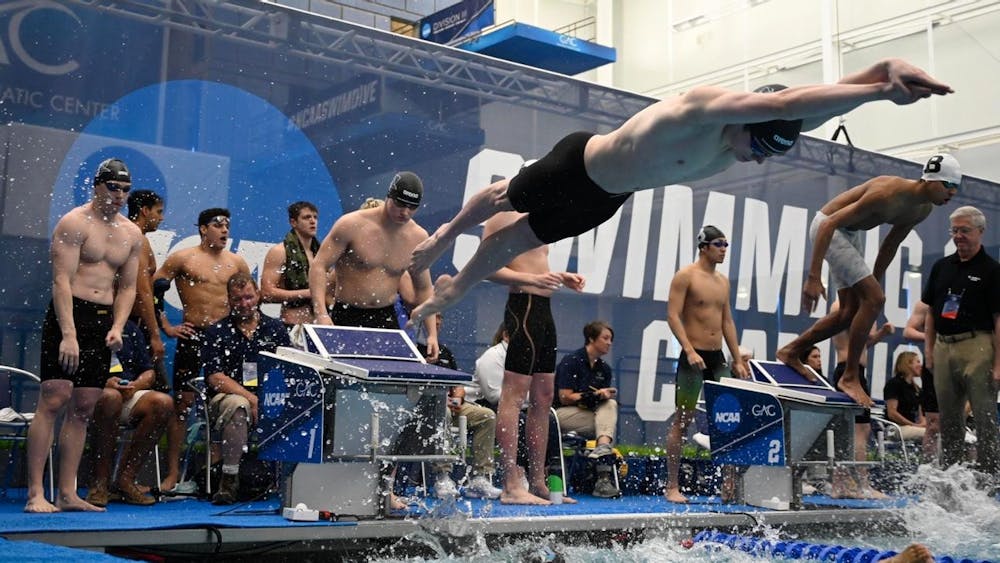In general, regular season training is to prepare for the biggest competition of the year, and for Hopkins swimming, this is the 2023 Division III Swimming and Diving Championships in Greensboro, N.C. Having been seeded to be 16th or 17th on the women’s side and 10th on the men’s side, there were slim chances of the teams finishing even in the top five. Coupled with other hurdles thrown their way, this made a strong showing at the meet much harder but the Jays pulled through with stunning performances.
Historically, Hopkins has always had strong distance swimmers, and current sophomore Kristin Cornish and junior Kellen Roddy are no exception. Both left the meet as national champions, Cornish in the 500 yard freestyle and 1650 yard freestyle and Roddy also in the 1650 yard freestyle.
For the men, freshman Avery Clapp led the team to a fourth-place finish in the 200 yard butterfly, earning 45 more points. He also broke the University record, dropping 1.35 seconds off his preliminary time and finishing with a 1:46.25. Senior Kyle Wu won the consolation final of the 100 Breast, swimming a personal best and earning him his third straight All-America honor in the event. Senior Steven Rua placed sixth in the 100 Back consolation final, going a bit slower than his preliminary time (48.07) but earning his first All-America honor in the event.
On the women’s side, senior Emerson Davis finished fifth in the consolation final of the 200 yard butterfly, finishing 13th overall and making this her first time swimming in the finals after the 2020 and 2021 championships were canceled due to COVID-19. The 400 free relay, consisting of junior Makenzie Higgins, sophomore Michelle Liu and graduate students Sophia Girgenti and Kristen Alicea-Jorgensen, finished 11th overall and also earned All-America honors.
The final team results were much better than how the teams were initially seeded. The men’s team finished in fourth with a score of 217, behind Emory University, Kenyon College and the University of Chicago. The women’s team ended in eleventh place with 126.5 points.
But what if I told you they accomplished this — a final-four team — without a pool?
Imagine playing basketball on a half-court. Imagine playing baseball without an outfield. Imagine playing football with no yard markings on the turf. Imagine playing tennis without a net. Now imagine swimming without a pool — a proper pool. This is exactly what the Hopkins swim team had to overcome this past athletic season.
A broken bulkhead at the Hopkins pool has rendered the pool almost useless to the top-tier swimmers. The team practiced in a 38-yard pool, an immense difference from the 25-yard pools that they’re used to swimming, training and competing in. The lane lines were held together with foam pool noodles, creating no structure to the already flimsy lines. There were no lines at the bottom of the pool and no markers at the walls, making pacing and turns incredibly difficult. Flags were temporarily installed, but any swimmer will tell you that having flags is a bare minimum.
Additionally, the Hopkins pool facilities are much smaller than other Division III institutions. Since the facility is a part of the recreation center, the team also has limited time in the water due to public recreational swim hours. Due to the inability to use the pool, the Blue Jays were not able to host any home meets, having to travel to other universities like Delaware, Georgetown and New York University for dual meets and losing previously scheduled matchups including a meet against Bucknell.
Having faced all of this adversity, the success of the team at the NCAA Championships meant so much more to many, including Hopkins alum and Head Coach Scott Armstrong, who put into perspective the environment of the meet and how they were able to move up so many spots.
“You never know what they look like until you’re there. The four days are long and a lot changes over the course of the meet,” he said. “Our team was so prepared, both mentally and emotionally for any bumps along the way. They were able to find ways to impact the meet. Particularly, the relays moved up a lot from where they were seeded. That drove a lot of our success.”
Though the 2022–2023 season is over, he has very high hopes for the next year.
“We can be a lot better next year — from the standpoint of having a much better pool,” he said. “The folks that came close to [the NCAA Championships] or were short of finals can definitely improve from having a better pool. We can have a plan. We can improve a lot within the current team right now.”
Armstrong shared his deep gratitude to those graduating and those who have used their fifth-year eligibility, noting that coming into college, having their athletic careers stunted by COVID-19 and coming back to compete in their last season in these conditions is not ideal. He commended the team as a whole on the grit that drove their success.
“I’m so proud of them,” he said. “I can’t even put into words how unreasonably difficult this season was, and it comes down to their character, their culture and their fight. It’s just unbelievable.”





